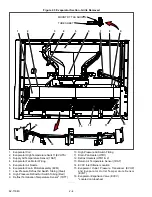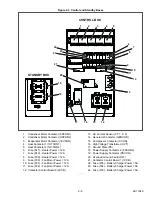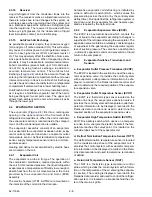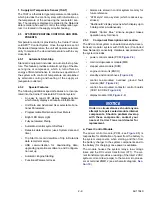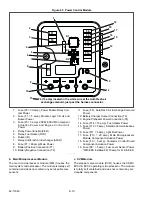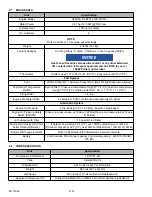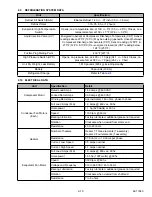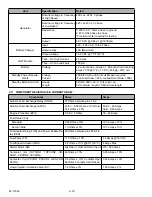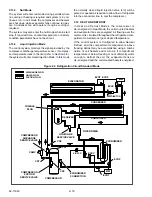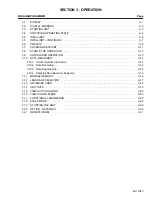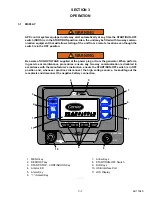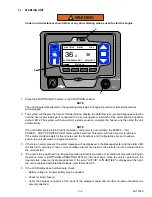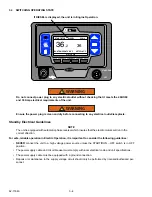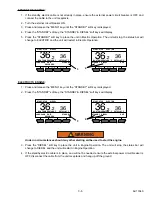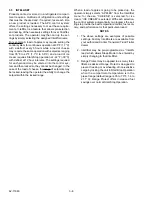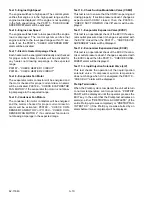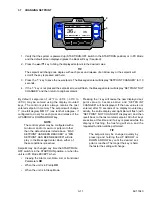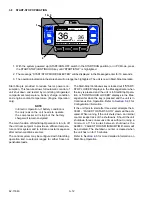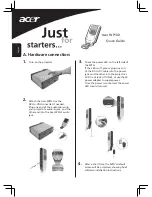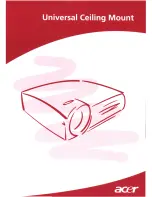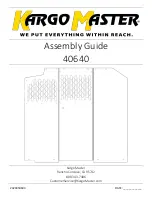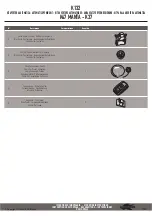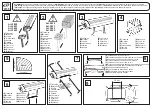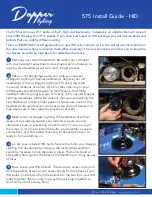
2–17
62-11640
2.12 SAFETY DEVICES
The system is protected from high pressure conditions which may occur when exposed to very high temperatures
(such as a fire) by a fusible plug mounted in the receiver. Under very high temperature conditions (refer to
) the plug will melt, releasing the refrigerant pressure.
System components are protected from damage caused by unsafe operating conditions by automatic shut-down of
the unit when such conditions occur. This is accomplished by the safety devices listed in the following table and the
fuses shown in
2.13 REFRIGERATION CIRCUIT DURING COOL-
ING
When cooling, the unit operates as a vapor compres-
sion refrigeration system. The main components of the
system are: the (1) scroll compressor, (2) air-cooled
condenser, (3) evaporator expansion valve, (4) direct
expansion evaporator and (5) economizer circuit.
The refrigeration system will operate in one of three
modes; Standard, Economized or Null. In addition, the
system may also operate in Liquid Injection mode. At
start and during periods of high refrigeration system
load, the system will operate in standard mode. This
allows the system to place the unit in operation at
reduced capacity and measure actual load. If the
microprocessor calculates additional capacity is
required and power is available (periods of high load or
during pull
−
down), the system will transition to econo-
mized mode.
2.13.1
Standard Mode
In standard mode, (see
), the compressor
raises the pressure and the temperature of the refriger-
ant and forces it into the condenser channels. The con-
denser fans circulate surrounding air over the outside
of the condenser. The channels have fins designed to
improve the transfer of heat from the refrigerant gas to
the air. This removal of heat causes the refrigerant to
condense. Liquid refrigerant leaves the condenser and
flows to the receiver.
The receiver stores the additional charge necessary for
low ambient operation. The receiver is equipped with a
fusible plug. The refrigerant leaves the receiver and
flows through the liquid line service valve to the sub-
cooler. The subcooler occupies a portion of the main
condensing coil surface and gives off further heat to the
passing air.
The refrigerant then flows through a filter-drier where
an absorbent keeps the refrigerant clean and dry.
The liquid then flows through the economizer (which is
not active in standard mode) and into the evaporator
expansion valve (EVXV). The EVXV reduces the pres-
sure of the liquid and meters the flow of liquid refriger-
ant to the evaporator to obtain maximum use of the
evaporator heat transfer surface.
The refrigerant pressure drop caused by the expansion
valve is accompanied by a drop in temperature so the
low pressure, low temperature liquid that flows into the
evaporator tubes is colder than the air that is circulated
over the evaporator tubes by the evaporator fan. The
evaporator tubes have aluminum fins to increase heat
transfer; therefore heat is removed from the air circu-
lated over the evaporator. This cold air is circulated
throughout the refrigerated compartment to maintain
the cargo at the desired temperature.
The transfer of heat from the air to the low temperature
liquid refrigerant causes the liquid to vaporize.
This low temperature, low pressure vapor passes the
evaporator outlet temperature and pressure sensors
(EVOT and EVOP) which aid in calculation of superheat.
The vapor then returns to the compressor through the
compressor suction modulation valve (CSMV). The
CSMV controls the flow of refrigerant entering the suc-
tion line, thereby matching the load to the compressor
capacity.
2.13.2
Economized Mode
In the economized mode the “main” refrigeration sys-
tem operates the same as in the Standard Mode
except the control system operates (opens) the econo-
mizer expansion valve (ECXV). With the economizer
expansion valve operating (see
ity of the unit is increased by subcooling the liquid
refrigerant entering the evaporator expansion valve.
Liquid refrigerant for use in the economizer circuit is
taken from the main liquid line as it leaves the filter
drier. This liquid refrigerant flows through the econo-
mizer expansion valve (ECXV) and the economizer
heat exchanger internal passages absorbing heat from
the liquid refrigerant flowing to the evaporator expan-
sion valve. Overall efficiency is increased because the
gas leaving the economizer enters the compressor at a
higher pressure, therefore requiring less energy to
compress it to the required condensing conditions.
There are two levels of economized mode, full econo-
mized mode and limited economized mode. Limited
economized mode is entered when the control system
requests higher capacity than standard mode but
engine power or system current limit will not allow full
economizer superheat control.
Unsafe Conditions
Safety Device
Device Setting
Excessive operating pressure
High Pressure Switch (HPS)
Summary of Contents for Vector 8500
Page 23: ...62 11640 1 6 1 3 SAFETY DECALS ...
Page 24: ...1 7 62 11640 62 03958 ...
Page 25: ...62 11640 1 8 ...
Page 26: ...1 9 62 11640 ...
Page 27: ...62 11640 1 10 ...
Page 125: ...62 11640 SECTION 6 MESSAGECENTER PARAGRAPH NUMBER Page 6 1 MESSAGECENTER MESSAGES 6 1 ...
Page 321: ......
Page 322: ......


